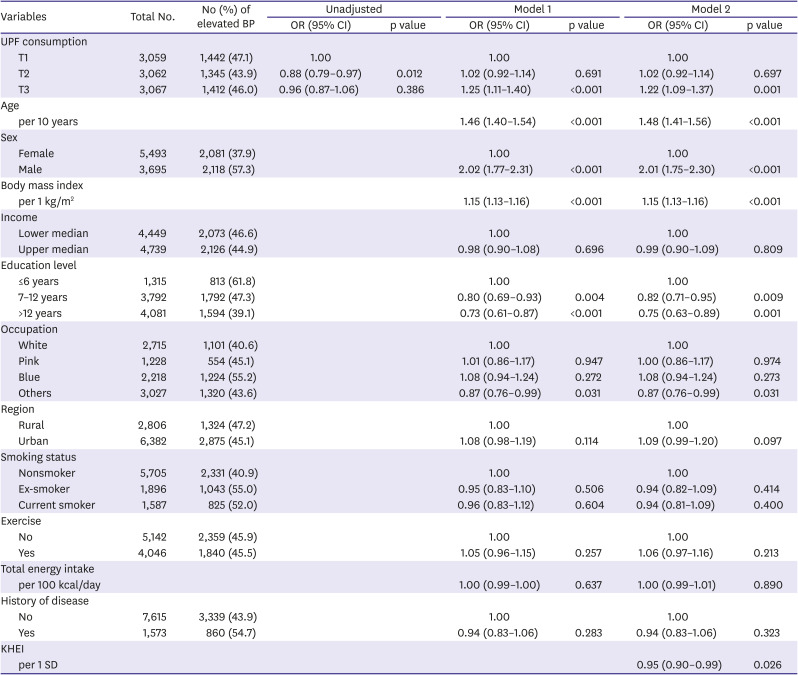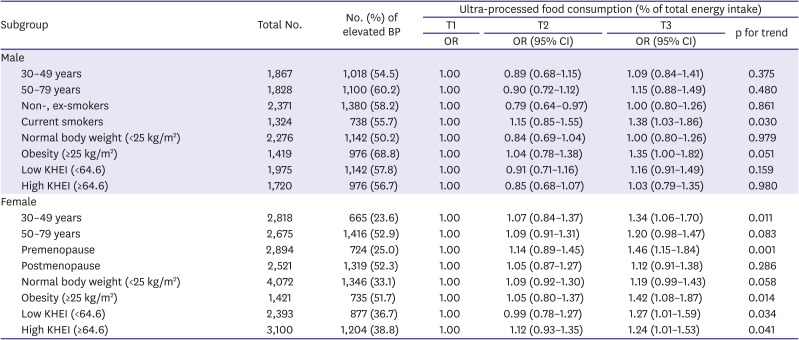1. Brunström M, Carlberg B. Association of blood pressure lowering with mortality and cardiovascular disease across blood pressure levels: a systematic review and meta-analysis. JAMA Intern Med. 2018; 178:28–36. PMID:
29131895.
2. Sheppard JP, Tucker KL, Davison WJ, et al. Self-monitoring of blood pressure in patients with hypertension-related multi-morbidity: systematic review and individual patient data meta-analysis. Am J Hypertens. 2020; 33:243–251. PMID:
31730171.

4. Vasan RS, Larson MG, Leip EP, et al. Impact of high-normal blood pressure on the risk of cardiovascular disease. N Engl J Med. 2001; 345:1291–1297. PMID:
11794147.

5. Primatesta P, Falaschetti E, Gupta S, Marmot MG, Poulter NR. Association between smoking and blood pressure: evidence from the health survey for England. Hypertension. 2001; 37:187–193. PMID:
11230269.
6. Park S, Rink L, Wallace J. Accumulation of physical activity: blood pressure reduction between 10-min walking sessions. J Hum Hypertens. 2008; 22:475–482. PMID:
18463671.

7. He FJ, MacGregor GA. Salt and sugar: their effects on blood pressure. Pflugers Arch. 2015; 467:577–586. PMID:
25547872.

8. Juul F, Martinez-Steele E, Parekh N, Monteiro CA, Chang VW. Ultra-processed food consumption and excess weight among US adults. Br J Nutr. 2018; 120:90–100. PMID:
29729673.

9. Monteiro CA, Cannon G, Moubarac JC, Levy RB, Louzada ML, Jaime PC. The UN decade of nutrition, the NOVA food classification and the trouble with ultra-processing. Public Health Nutr. 2018; 21:5–17. PMID:
28322183.

10. Monteiro CA, Levy RB, Claro RM, de Castro IR, Cannon G. Increasing consumption of ultra-processed foods and likely impact on human health: evidence from Brazil. Public Health Nutr. 2011; 14:5–13. PMID:
21211100.

11. Moubarac JC, Batal M, Martins AP, et al. Processed and ultra-processed food products: consumption trends in Canada from 1938 to 2011. Can J Diet Pract Res. 2014; 75:15–21. PMID:
24606955.

12. Monteiro CA, Cannon G, Levy RB, et al. Ultra-processed foods: what they are and how to identify them. Public Health Nutr. 2019; 22:936–941. PMID:
30744710.

13. Srour B, Fezeu LK, Kesse-Guyot E, et al. Ultra-processed food intake and risk of cardiovascular disease: prospective cohort study (NutriNet-Santé). BMJ. 2019; 365:l1451. PMID:
31142457.

14. Tavares LF, Fonseca SC, Garcia Rosa ML, Yokoo EM. Relationship between ultra-processed foods and metabolic syndrome in adolescents from a Brazilian Family Doctor Program. Public Health Nutr. 2012; 15:82–87. PMID:
21752314.

15. Fiolet T, Srour B, Sellem L, et al. Consumption of ultra-processed foods and cancer risk: results from NutriNet-Santé prospective cohort. BMJ. 2018; 360:k322. PMID:
29444771.

16. Mendonça RD, Lopes ACS, Pimenta AM, Gea A, Martinez-Gonzalez MA, Bes-Rastrollo M. Ultra-processed food consumption and the incidence of hypertension in a Mediterranean cohort: The Seguimiento Universidad de Navarra Project. Am J Hypertens. 2017; 30:358–366. PMID:
27927627.

17. Nardocci M, Polsky JY, Moubarac JC. Consumption of ultra-processed foods is associated with obesity, diabetes and hypertension in Canadian adults. Can J Public Health. 2021; 112:421–429. PMID:
33174128.

18. Rezende-Alves K, Hermsdorff HH, Miranda A, Lopes AC, Bressan J, Pimenta AM. Food processing and risk of hypertension: cohort of Universities of Minas Gerais, Brazil (CUME Project). Public Health Nutr. 2021; 24:4071–4079. PMID:
32758322.
19. Scaranni PO, Cardoso LO, Chor D, et al. Ultra-processed foods, changes in blood pressure and incidence of hypertension: the Brazilian Longitudinal Study of Adult Health (ELSA-Brasil). Public Health Nutr. 2021; 24:3352–3360. PMID:
33658095.
20. Kweon S, Kim Y, Jang MJ, et al. Data resource profile: the Korea National Health and Nutrition Examination Survey (KNHANES). Int J Epidemiol. 2014; 43:69–77. PMID:
24585853.
21. Lee JS, Shim JS, Kim KN, Lee HS, Chang MJ, Kim HY. Key foods selection using data from the 7th Korea National Health and Nutrition Examination Survey (2016–2018). J Nutr Health. 2021; 54:10–22.
22. Shim JS, Shim SY, Cha HJ, Kim J, Kim HC. Socioeconomic characteristics and trends in the consumption of ultra-processed foods in Korea from 2010 to 2018. Nutrients. 2021; 13:1120. PMID:
33805412.
23. Shim JS, Shim S, Cha HJ, Kim J, Kim HC. Association between ultra-processed food consumption and dietary intake and diet quality in Korean adults. J Acad Nutr Diet. 2021; [Epub ahead of print].
24. Oh JY, Yang YJ, Kim BS, Kang JH. Validity and reliability of Korean version of international physical activity questionnaire (IPAQ) short form. J Korean Acad Fam Med. 2007; 28:532–541.
25. Shim JS, Oh K, Jung SJ, Kim HC. Self-reported diet management and adherence to dietary guidelines in Korean adults with hypertension. Korean Circ J. 2020; 50:432–440. PMID:
32096363.
26. Flack JM, Adekola B. Blood pressure and the new ACC/AHA hypertension guidelines. Trends Cardiovasc Med. 2020; 30:160–164. PMID:
31521481.
27. Martínez Steele E, Khandpur N, da Costa Louzada ML, Monteiro CA. Association between dietary contribution of ultra-processed foods and urinary concentrations of phthalates and bisphenol in a nationally representative sample of the US population aged 6 years and older. PLoS One. 2020; 15:e0236738. PMID:
32735599.
28. Chassaing B, Koren O, Goodrich JK, et al. Dietary emulsifiers impact the mouse gut microbiota promoting colitis and metabolic syndrome. Nature. 2015; 519:92–96. PMID:
25731162.
29. Li J, Zhao F, Wang Y, et al. Gut microbiota dysbiosis contributes to the development of hypertension. Microbiome. 2017; 5:14. PMID:
28143587.









 PDF
PDF Citation
Citation Print
Print



 XML Download
XML Download